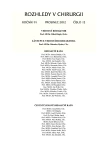Wound microbial sampling methods in surgical practice, imprint techniques
Authors:
Z. Chovanec 1; L. Veverková 1; M. Votava 2; J. Svoboda 2; A. Peštál 2; J. Doležel 1; V. Jedlička 1; M. Veselý 1; J. Wechsler 1; I. Čapov 1
Authors‘ workplace:
I. chirurgická klinika LF MU a Fakultní nemocnice u svaté Anny v Brně
přednosta: Prof. MUDr. I. Čapov, CSc.
1; Mikrobiologický ústav LF MU a Fakultní nemocnice u svaté Anny v Brně
přednosta: Doc. MUDr. F. Růžička, Ph. D.
2
Published in:
Rozhl. Chir., 2012, roč. 91, č. 12, s. 654-659.
Category:
Review
Overview
The wound is a damage of tissue. The process of healing is influenced by many systemic and local factors. The most crucial and the most discussed local factor of wound healing is infection. Surgical site infection in the wound is caused by micro-organisms. This information is known for many years, however the conditions leading to an infection occurrence have not been sufficiently described yet. Correct sampling technique, correct storage, transportation, evaluation, and valid interpretation of these data are very important in clinical practice.
There are many methods for microbiological sampling, but the best one has not been yet identified and validated. We aim to discuss the problem with the focus on the imprint technique.
Key words:
wound – infection – microbial sampling – filter paper pad
Sources
1. Stryja J. Repetitorium hojení ran. 1. vydání, Semily, GEUM 2008.
2. Cutting KF, White RJ, Mahoney P. Clinical identification of wound infection: a Delphi approach. In: EWMA Position Document. Identifying criteria for wound infection. London, MEP Ltd, 2005.
3. Bruce J, Russell EM, Mollison J et al. The quality of measurement of surgical wound infection as the basis for monitoring: a systematic review. Journal of Hospital Infection 2001; 49(2): 99–108.
4. Wilson APR, Treasure T, Sturridge MF et al. A scoring method (ASEPSIS) for postoperative wound infections for use in clinical trials of antibiotic prophylaxis. The Lancet 1986;1(8476): 311 –313.
5. Horan TC, Gaynes RP, Martone WJ et al. CDC definitions of nosocomial surgical site infections, a modification of CDC definitions of surgical wound infections. American Journal of Infection Control 1992;20(5):271–274.
6. Benbow, M. Wound swabs and chronic wounds. Practice Nurse 2010;39(9):27.
7. Rondon MC. Lessons gleaned from the sport of wound watching. Wound Repair Regeneration 1999;7:2–6.
8. Heggers JP, Rondon MC. Quantitative bacteriology: its role in the armamentarium of a surgeon. 1st edition Boca Raton (Florida, USA), CRC Press 1991:1–139.
9. Rondon MC. Wound infection. A failure of wound healing caused by an imbalance of bacteria. Surgical Clinic of North America 1997;77:637–650.
10. Bornside GH, Bornside BB. Comparison between moist swab and tissue biopsy methods for quantisation of bacteria in experimental incisional wounds. Journal of Trauma 1979;19:103–105.
11. Schneider M, Vildozola CW, Brooks S. Quantitative assessment of bacterial invasion of chronic ulcers. Statistical analysis. American Journal of Surgery 1983;145:260–262.
12. Dow G, Browne A, Sibbald RG. Infection in chronic wound: controversies in diagnosis and treatment. Osteotomy wound manager 1999;45(8):23–40.
13. Kiernan, M. Role of swabbing in wound infection management. Community Nurse 1998;4(6):45–46.
14. Laing P. Diabetic foot ulcers. American Journal of Surgery 1994;167:31–36.
15. Gilchrist B. Wound infection. Sampling bacterial flora: a review of literature. Journal of Wound Care 1996;5:386–8.
16. Cuzzell JZ. The right way to culture a wound. American Journal of Nursing 1993;93(5):48–50.
17. Bowler PG, Duerden BI. Armstrong DG. Wound microbiology and associated approaches to wound management. Clinical Microbiology Reviews 2001;14:244–269.
18. Thomson PD, Smith DJ. What is infection? American Journal of Surgery 1994;167:7–11.
19. Johnson S, Lebahn F, Peterson LR et al. Use of an anaerobic collection and transport swab device to recover anaerobic bacteria from infected foot ulcers in diabetics. Clinical Infection Disease 1995;20:289–290.
20. Hrabák J, Bunček M, Denis M et al. Aplikace metod molekulární genetiky v klinické mikrobiologii: Zpráva z jednání Pracovní skupiny molekulární mikrobiologie TIDE. Epidemiologie, Mikrobiologie, Imunologie 2010;59:103–106.
21. Craythorn JM, Barbour AG, Matsen JM et al. Membrane Filter Contact Technique for Bacteriological Sampling of Moist Surfaces. Journal of Clinical Mikrobiology 1980;12(2):250–255.
22. Lederberg J, Lederberg EM. Replica plating and indirect selection of bacterial mutants. Journal of Bacteriology 1952;63(3):399.
23. Raahave D. Agar contact plates in evaluatix skin-disinfection. Dan Med Bull 1973;20:204–208.
24. Holt RJ. Pad culture studies on skin surface. Appl Bacteriol 1966;29:625–630.
25. Gorrill RH, Penikett EJK. New Method of studying the bacterial flora of infected open wounds and burns. Lancet 1957;II: 370–372.
26. Raahave, D. Bacterial density in operation wounds. Acta Chirurgica Scandinavia 1974;140:585–593.
27. Gjødsbøl K, Skindersoe ME, Christensen JJ et al. No need for biopsies: comparison of three sample techniques for wound microbiotics determination. Int. Wound Journal 2012;9:295–302.
28. Rusanen P, Siikala E, Uittamo J et al. A novel method for sampling the microbiota from the oral mucosa. Clin Oral Investig 2009;13(2):243–6.
29. Toršová V, Piegzova L. Nový pohled na léčbu ran z mikrobiologického hlediska, Kongres s vlídnou tváří, konference sestra v akci, Olomouc 2008, Solen 4–5.
Labels
Surgery Orthopaedics Trauma surgeryArticle was published in
Perspectives in Surgery

2012 Issue 12
Most read in this issue
- STARR surgery in the treatment of rectocele and rectal intussusception
- Upside down stomach
- Classification of surgical complications: analysis of the group of consecutive patients
- Lung pneumatocele in adult patient – case report
